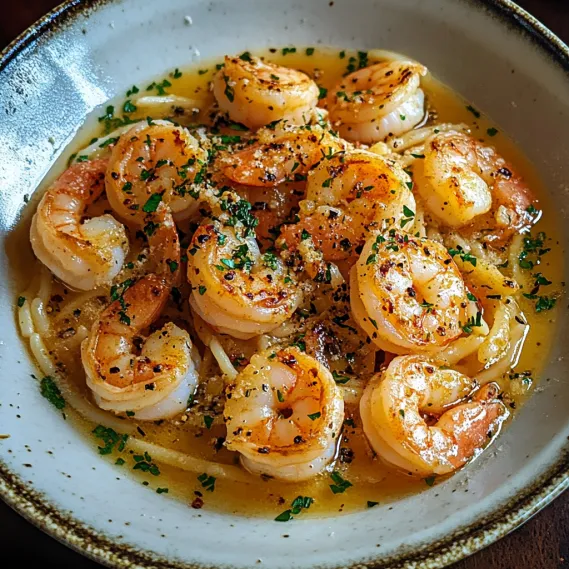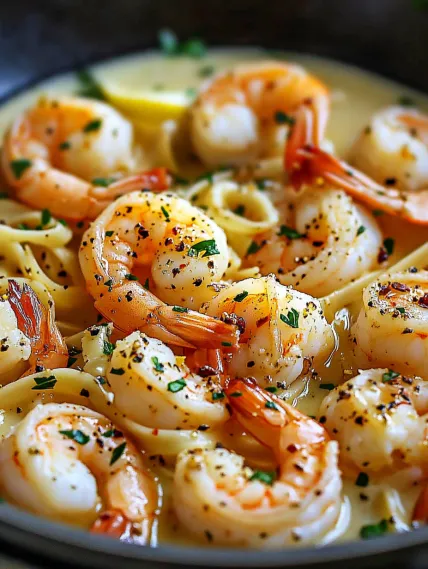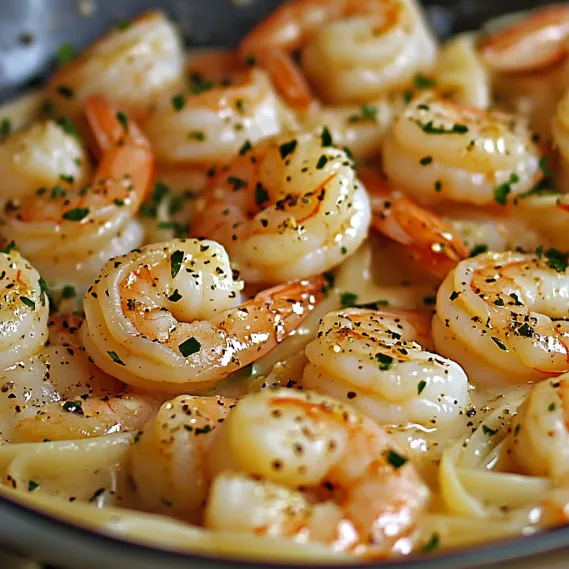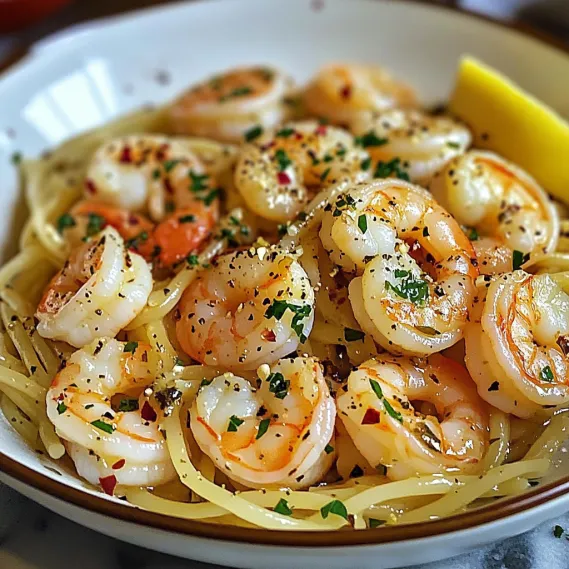 Pin
Pin
Classic Shrimp Scampi transforms fresh shrimp into an elegant dinner with minimal effort. Plump shrimp are sautéed until pink, then bathed in a luxurious sauce of butter, olive oil, garlic, wine and lemon. Ready in just 20 minutes, it tastes like fine restaurant dining.
I first made this recipe when looking for an impressive yet manageable dish for weekend entertaining. After experimenting with various cuts of shrimp and butter combinations, this version became an instant favorite. My husband declared them the best scampi he's ever tasted, and now guests always request them at our gatherings.
Essential Ingredients and Selection Tips
- Shrimp: Large or extra-large (16-25 count), fresh or properly thawed frozen
- Garlic: Fresh cloves, minced just before cooking
- Butter: Unsalted European-style for silkier sauce
- Wine: Dry white like Pinot Grigio or Sauvignon Blanc
- Lemon: Fresh-squeezed juice balances richness and brightens all flavors
I've found that adding a small amount of chicken powder (bouillon) makes a significant difference in achieving that authentic takeaway flavor. If you don't have it, mushroom powder makes an excellent substitute that adds similar umami depth without changing the overall profile of the dish.
Detailed Cooking Instructions
- Step 1: Prepare Your Shrimp with Care
- Pat dry one pound of shrimp and season lightly with salt and pepper. Removing excess moisture ensures proper searing rather than steaming in the pan.
- Step 2: Create the Perfect Cooking Base
- Melt butter with olive oil over medium heat. This combination provides butter flavor without burning, as oil raises butter's smoke point. The mixture should foam slightly but not brown.
- Step 3: Develop Aromatic Complexity
- Add minced garlic and red pepper flakes to the warm butter-oil mixture. Sauté for 60-90 seconds until fragrant but not browned. This infuses the fats with garlic flavor while preserving aromatics.
- Step 4: Cook the Shrimp with Precision
- Cook shrimp in a single layer, undisturbed for 2 minutes, then flip for another 1-2 minutes until just opaque. Remove immediately to prevent overcooking. They should form a loose 'C' shape when done.
- Step 5: Create a Harmonious Sauce
- Deglaze with white wine, scraping up browned bits. Simmer until reduced by half, then add lemon juice and parsley. Return shrimp to coat with sauce and rewarm briefly.

My first attempt at these shrimp scampi taught me the importance of having super hot wok before adding ingredients. Now I heat the wok until it's lightly smoking before adding oil, which creates that distinctive restaurant-quality flavor that's impossible to achieve at lower temperatures. This simple technique transformed my homemade fried rice.
The Secret to Non-Sticky Rice
Cold, day-old rice is essential because freshly cooked rice contains too much moisture, resulting in soggy fried rice. Refrigerating rice overnight allows it to dry out slightly, creating perfect individual grains that remain separate when stir-fried. For best results, cook rice with slightly less water than normal.

Creating Authentic Takeaway Flavor
The distinctive taste of restaurant fried rice comes from 'wok hei' – the smoky flavor from high-heat cooking in a well-seasoned wok. Using highest heat possible, cooking quickly, and keeping ingredients moving constantly helps recreate this at home. Don't be afraid of the sizzle and steam – they're signs of good wok hei.
Perfect Protein Balance
Special fried rice stands out because of its generous protein content. Balance is key – prawns should be just cooked to remain tender, eggs should form small, soft pieces throughout, and char siu provides sweet-savory notes. Each protein cooks at different rates, so add them sequentially rather than all at once.
Vegetable Options for Color and Nutrition
Traditional special fried rice includes green peas and carrots, but don't limit yourself. Add diced bell peppers, bean sprouts, sweet corn, or baby corn for extra color and nutrition. For authentic restaurant style, keep vegetables small and uniform to incorporate evenly among the rice grains.
Common Mistakes to Avoid
Overcrowding the wok reduces temperature, creating steamed rather than fried rice. Using too much sauce makes rice soggy. Overcooking vegetables leads to mushy texture. Adding all ingredients simultaneously prevents proper cooking of each component. Extended cooking times result in dry, hard rice grains.

Chef's Helpful Tips
- Use chopsticks or a fork to break up rice grains before cooking
- Cook each ingredient separately before combining for best texture
- Add soy sauce around the sides of the wok for instant caramelization
- Finish with a drizzle of sesame oil for aromatic nutty flavor
- Keep the wok moving constantly to prevent sticking and burning
- If wok sticks to the pan, add a few drops of water and gently loosen with a spatula
- For a complete meal, serve three or four portions of fried rice per person as an appetizer or ten to twelve as a main dish
I've been making variations of this pie for over a decade, constantly refining the technique. The most significant improvement came when I started using the broiler to finish the salmon, creating that perfect balance of crisp exterior and tender, juicy interior.
Recipe FAQs
- → What type of white wine works best for shrimp scampi?
- Dry white wines work best for shrimp scampi because they add acidity and flavor without too much sweetness. Good options include Pinot Grigio, Sauvignon Blanc, Chardonnay (unoaked), or Vermentino. Always choose a wine you would enjoy drinking, as the flavor will concentrate in the sauce. If you prefer not to use alcohol, chicken broth makes a good substitute, though you might want to add a little extra lemon juice to compensate for the missing acidity.
- → How do I know when the shrimp are perfectly cooked?
- Perfectly cooked shrimp change from translucent gray to opaque pink and form a loose 'C' shape. If they curl into a tight 'O' shape, they're overcooked. The best approach is to watch them closely - they only need about 2 minutes per side. Another visual cue is when the flesh turns from translucent to opaque all the way through. Remove them from the heat just as they finish turning pink to prevent them from becoming tough and rubbery.
- → Can I use frozen shrimp for this recipe?
- Yes, frozen shrimp work well for this recipe and are often fresher than 'fresh' shrimp at the seafood counter (which are usually previously frozen and thawed). Thaw frozen shrimp overnight in the refrigerator or place them in a colander under cold running water for 5-7 minutes. Either way, be sure to pat them thoroughly dry with paper towels before cooking to ensure proper searing and to prevent the sauce from becoming watery.
- → What's the best pasta to serve with shrimp scampi?
- Long, thin pasta shapes like linguine, spaghetti, or angel hair (capellini) are traditional choices for shrimp scampi as they hold the light sauce well. For a more substantial option, wider noodles like fettuccine work nicely too. If you want to try something different, orecchiette or farfalle can catch little pools of the delicious sauce in their shapes. For a lighter meal, zucchini noodles offer a low-carb alternative that pairs beautifully with the bright flavors of the dish.
- → How can I make this recipe dairy-free?
- To make dairy-free shrimp scampi, replace the butter with either all olive oil or a combination of olive oil and a dairy-free butter substitute made from plant oils. Omit the Parmesan cheese, or use a dairy-free Parmesan alternative if desired. The dish will have a slightly different flavor profile but will still be delicious, as the garlic, wine, lemon, and parsley contribute significantly to the classic scampi taste.
